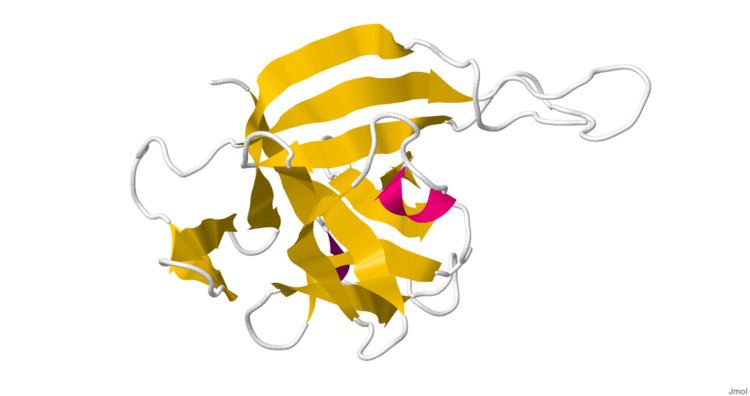Entrez 90865 | Ensembl ENSG00000137033 | |
 | ||
Aliases IL33, C9orf26, DVS27, IL1F11, NF-HEV, NFEHEV, Interleukin 33, IL-33 External IDs MGI: 1924375 HomoloGene: 14126 GeneCards: IL33 | ||
Interleukin 33 (IL-33) is a protein that in humans is encoded by the IL33 gene.
Contents
Interleukin 33 is a member of the IL-1 family that potently drives production of T helper-2 (Th2)-associated cytokines (e.g., IL-4). IL33 is a ligand for ST2 (IL1RL1), an IL-1 family receptor that is highly expressed on Th2 cells, mast cells and group 2 innate lymphocytes.
IL-33 is expressed by a wide variety of cell types, including fibroblasts, mast cells, dendritic cells, macrophages, osteoblasts, endothelial cells, and epithelial cells.
Structure
IL-33 is a member of the IL-1 superfamily of cytokines, a determination based in part on the molecules β-trefoil structure, a conserved structure type described in other IL-1 cytokines, including IL-1α, IL-1β, IL-1Ra and IL-18. In this structure, the 12 β-strands of the β-trefoil are arranged in three pseudorepeats of four β-strand units, of which the first and last β-strands are antiparallel staves in a six-stranded β-barrel, while the second and third β-strands of each repeat form a β-hairpin sitting atop the β-barrel. IL-33 is a ligand that binds to a high-affinity receptor family member ST2. The complex of these two molecules with IL-1RAcP indicates a ternary complex formation. The binding area appears to be a mix of polar and non-polar regions that create a specific binding between ligand and receptor. The interface between the molecules has been shown to be extensive. Structural data on the IL-33 molecule was determined by solution NMR and small angle X-ray scattering.
Function
Interleukin 33 (IL-33) is a cytokine belonging to the IL-1 superfamily. IL-33 induces helper T cells, mast cells, eosinophils and basophils to produce type 2 cytokines. This cytokine was previously named NF-HEV 'nuclear factor (NF) in high endothelial venules' (HEVs) since it was originally identified in these specialized cells. IL-33 acts intracellularly as a nuclear factor and extracellularly as a cytokine.
Nuclear role
IL-33 is constitutively located in the nucleus of structural cells of humans and mice and has a helix-turn-helix domain presumably allowing it to bind to DNA. There is a paucity of research into the nuclear role of IL-33 but amino acids 40-58 in human IL-33 are sufficient for nuclear localisation and histone binding. IL-33 also interacts with the histone methyltransferase SUV39H1 and murine appears to IL-33 interact to NF-κB.
Cytokine role
As a cytokine, IL-33 interacts with the receptors ST2 (also known as IL1RL1) and IL-1 Receptor Accessory Protein (IL1RAP), activating intracellular molecules in the NF-κB and MAP kinase signaling pathways that drive production of type 2 cytokines (e.g. IL-5 and IL-13) from polarized Th2 cells. The induction of type 2 cytokines by IL-33 in vivo is believed to induce the severe pathological changes observed in mucosal organs following administration of IL-33. IL-33 is also effective in reversing Alzheimer-like symptoms in APP/PS1 mice, by reversing the buildup and preventing the new formation of amyloid plaques.
Regulation
Extracellularly, IL-33 is rapidly oxidised. The oxidation process results in the formation of two disulphide bridges and a change in the conformation of the molecule, which prevents it from binding to its receptor, ST2. This is believed to limit the range and duration of the action of IL-33.
Clinical significance
IL-33 has been associated with several disease states through Genome Wide Association Studies: asthma, allergy, endometriosis, and hay fever.
